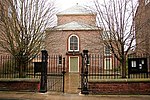Quilt Museum and Gallery

The Quilters' Guild Museum Collection, which opened in St Anthony's Hall, York on 7 June 2008, was Britain's first museum dedicated to the history of British quilt making and textile arts. The museum was founded and operated by The Quilters' Guild of the British Isles. The Guild was formed in 1979 and is the national organisation representing quilt makers throughout the country. Traditional and contemporary work is of equal importance within the Guild, and membership is open to anyone who works in patchwork, appliqué, and quilting, or has an interest in quilts. The Quilt Museum Gallery closed on 31 October 2015 but the Collection can be viewed on specific days free of charge. Details can be found on the Museum Collection website.The Quilters’ Guild continues to care for its Collection of historic and contemporary quilts and to make acquisitions. The Museum Collection is open free of charge to members of the public on specific dates which can be found at https://www.quiltmuseum.org.uk. The Guild continues to explore a wide range of opportunities for items from the Collection to be exhibited in other locations.
Excerpt from the Wikipedia article Quilt Museum and Gallery (License: CC BY-SA 3.0, Authors, Images).Quilt Museum and Gallery
City Walls, York Layerthorpe
Geographical coordinates (GPS) Address Nearby Places Show on map
Geographical coordinates (GPS)
| Latitude | Longitude |
|---|---|
| N 53.9605 ° | E -1.0758 ° |
Address
St Anthony's Garden
City Walls
YO1 7PP York, Layerthorpe
England, United Kingdom
Open on Google Maps









